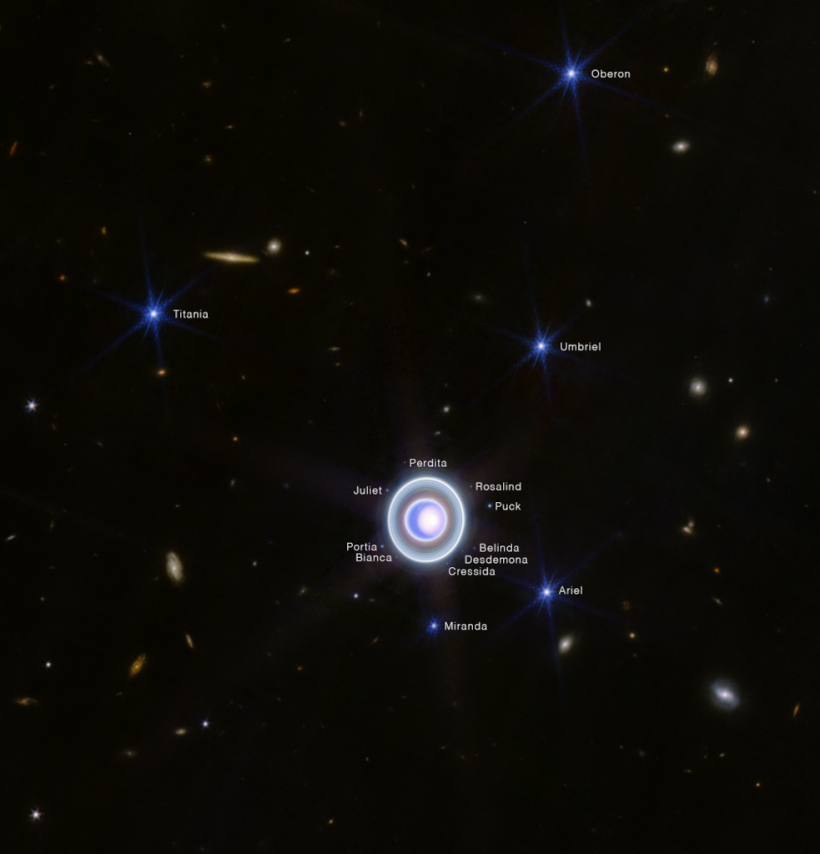NASA's Picture of the Day features a captivating convergence of Shakespearean inspiration and cosmic wonders, unveiling the ice giant Uranus as the star of the show.
NASA's James Webb Space Telescope Captures Uranus
While Voyager 2 made history with the first close-up exploration of Uranus in 1986, the James Webb Space Telescope, equipped with the Near-Infrared Camera (NIRCam), has now gifted humanity with a detailed portrait of this distant planetary giant.

The recently unveiled photograph taken by the NIRCam (Near-Infrared Camera) aboard the James Webb Space Telescope provides a comprehensive view of Uranus. The inclined outer planet completes one rotation on its axis approximately every 17 hours, with its current orientation aligning the north pole directly with our line of sight. This positioning grants clear observations of the planet's northern hemisphere and reveals a subtle yet expansive ring system, according to NASA.
The newly released image offers a captivating look at Uranus, a tilted outer planet gracefully rotating on its axis approximately every 17 hours.
With its north pole currently facing our line of sight, the image provides a direct view of Uranus' northern hemisphere, adorned with a faint yet expansive system of rings.
Among the 27 known moons of Uranus, 14 are highlighted in the image, their presence accentuated by the characteristic diffraction spikes of the Webb telescope.
The image not only showcases the beauty of Uranus and its lunar entourage but also pays homage to the enduring influence of William Shakespeare.
Although the moons and the outer Solar System were unknown in Shakespearean times, an intriguing tradition links these celestial bodies to characters from the English Bard's plays, according to NASA.
Read Also: NASA's James Webb Space Telescope Captures Stunning Image of 'Hidden' Ghostlike Dusty Galaxy
Shakespeare in Space
Rebecca Sheir, host of the Shakespeare Unlimited podcast series, shares insights into this celestial connection, noting that out of the 27 known moons of Uranus, all but two are named after characters from Shakespeare's literary masterpieces.
Names like Ophelia, Sycorax, Desdemona, and Perdita adorn the lunar landscape, weaving a poetic tapestry across the cosmos. Even the surface features of these moons, observed closely during Voyager's historic encounter, bear Shakespearean place names like Arden and Dunsinane on Miranda.
The image captured by NIRCam not only showcases the celestial ballet of Uranus and its moons but also highlights the intricate details of the planet's rings.
Adding to the celestial spectacle unveiled by the James Webb Space Telescope is the image of the elusive Zeta ring, the faint and diffuse ring closest to Uranus.
As the image takes center stage in NASA's Picture of the Day, it prompts contemplation of the historical progression that led to the tradition of naming celestial bodies after Shakespearean characters.
Sheir reflects on the deliberate choices in naming these moons, emphasizing that the celestial homage to Shakespeare's characters did not happen accidentally. Instead, it follows a historical trajectory shrouded in metaphorical mystery, much like the "thick-grown brake" of a Shakespearean play.
Related Article: New Computer Simulation Sheds Light on Early Galaxy Formation Aligned With NASA James Webb's Observations










